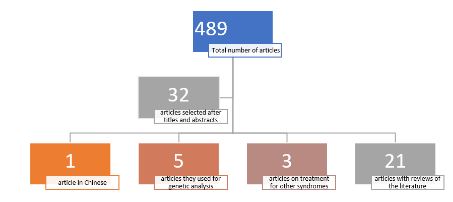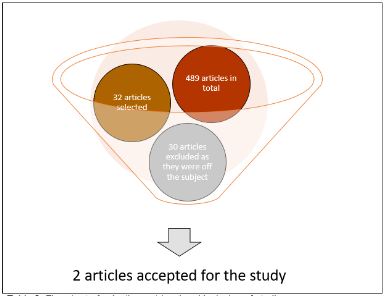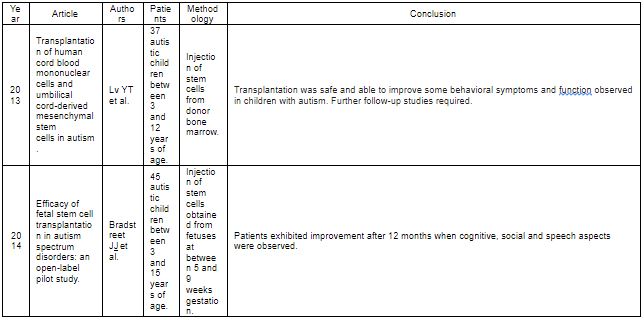Could Application of Stem Cells Improve Quality of Life of Patients With Autism Spectrum Disorder? Recent Insights
Amanda A. Coelho, Giovana Bernardes C, Maria Salete Nahás PC and Karla MR*
Department of Paediatric Dentistry, Faculty of Dentistry, University of Sao Paulo, Brazil
Received Date: 14/09/2020; Published Date: 15/10/2020
*Corresponding author: Karla Mayra Rezende, Department of Paediatric Dentistry, Faculty of Dentistry, University of Sao Paulo, Brazil. E-mail: karla.rezende@usp.br
Abstract
The available treatment for autism can be divided into three main approaches: behavioral, nutritional and medicinal. There has been an increasing amount of research into cell therapy, with a view to introducing it into ASD treatment as an alternative to the limited and rather ineffective treatments available. The aim of the present study was to perform a review of the literature to see if the use of stem cells is effective in treating patients with ASD.
Methods: A literature search conducted on Pubmed identified 489 paper, 2 which were included in the final review. Conclusion: The studies analyzed demonstrated that the application of stem cells has the capacity for minimum invasiveness and the virtual absence of side effects. However, there is a need for further investigation into stem-cell therapy for the treatment of autism, using a standard methodology for evaluating the success of treatment, as well as a longer period of monitoring to confirm or reject the tendency toward similarity among the approaches observed in the current review.
Keywords: Autism; Cell Therapy; Stem Cells; Treatment
Introduction
The use of stem cells as cell therapy, to replace the conventional therapeutic modality, has been the motivation for studies into the most diverse areas of health. This is due to the fact that these cells have the capacity for self-renewal and differentiation into one or more types of specialized cells which, when introduced into an organism, acquire the functionality of the receptor-tissue [1].
The incidence of autism has been increasing over the years and the limitations and adverse effects of the treatment currently available have made it necessary to bring our understanding of the etiology and its action mechanisms up-to-date, in order to help with the diagnosis, together with the choice of suitable treatment, with the aim of understanding the benefits of cell therapy. It is believed that autism affects 1% of the global population, both children and adults, and has been growing constantly over recent years [2]. Male children are the most affected (in a ratio of 4:1) and these patients are generally diagnosed at around three years of age, when the clinical symptoms become more apparent [3].
In 2013, the team led by Yong-Tao Lv studied the safety and efficacy of mononuclear stem cells obtained from cord blood and mesenchymal stem cells from the umbilical cord, in the treatment of children with autism. For this exercise, 37 children between the ages of 3 and 12 years received an application of these cells as part of their rehabilitation therapy. The authors concluded that the transplantation of stem cells could help with rehabilitation and to improve some of the characteristics of autism such as: behavioral symptoms, visual, emotional and intellectual responses, fear, nervousness and hyperactivity. This may be due to an increase in perfusion in specific areas of the brain and/or the regulation of immune dysfunction [4].
Sharma et al. studied if the application of stem cells from the bone marrow could improve the condition when combined with the therapy to which these patients are subjected in their current treatments, such as: occupational, speech and psychological. With this in mind, stem cells were applied to patients between 3 and 33 years of age. The evaluation was conducted using the Indian Scale for the Assessment of Autism (ISAA). In their conclusion, they observed improvements in social relations and reciprocity, hyperactivity, general communication responses (speech, language), improvement in behavioral patterns and sensorial and cognitive aspects. The younger the patient, the better the response to treatment. This is because the younger the patient, the greater the plasticity of cells in the brain [5].
In addition to the application of stem cells, other groups of researchers are trying to understand how and why autism occurs. To this end, the cell reprogramming technique conceived by Yamanaka in 2012 has been very useful for carrying out cellular reprograming [6].
As the collection of brain tissue is difficult and access to neuronal cells is restricted or forbidden, iPSC modeling allows us to reprogram the patient’s own cells, maintaining the genetic base, allowing us to consider customized medicine where medication is used individually for each patient [7].
Protocols for the generation of neurons in patients suffering from syndromes characteristic of autism, based on iPSCs, have, for example, been applied to Rett Syndrome [7], Fragile X Syndrome [8], Angelman Syndrome, Timothy Syndrome [9] and Phelan-McDermid Syndrome [10]. These studies revealed specific neuronal phenotypes, however they should be applied directly to ASD, seeing that, based on the latest classification in the Diagnostic and Statistical Manual of Mental Disorders (DSM), it excludes individuals with ASD diagnosed syndromes [11].
Despite the evidence of the involvement of neuronal changes and synaptic dysfunction, post-mortem studies have also shown microglia and astrocyte dysfunction in patients with ASD [12].
The aim of the present study was to investigate, by way of a systematic review, if stem-cell therapy could be an alternative for the treatment of ASD patients.
Methods
A search of the literature was carried out for articles that reported on research using stem cells in treatments with patients suffering from ASD, and indexed in PubMed. The subject search employed a combination of pre-defined or controlled vocabulary and free-text terms, based on the following search strategy:
Search (((((Stem cells OR mesenchymal stem cells OR embryonic stem cells OR Cell therapy OR ips cell))) AND ((children or child))) AND ((treatment or quality of life))) AND (((Autism OR autism spectrum disorder OR autism review OR autism children OR neurodevelopmental disorder))).
The articles selected for a review of the research results were those satisfying the following inclusion criteria: purpose-specific title/abstract and articles published in English. When only one relevant abstract without a listed title was available, a full copy of the article was evaluated for inclusion.
For the purposes of this review, the treatment of autism was defined as a procedure that includes application and treatment using stem cells. The criteria for the exclusion of articles were as follows: review of the literature; articles not published in the English language; patients outside the recommended age range (up to 15 years of age); research on animals.
Two researchers were assigned and trained in the evaluation of the selected articles. The training was administered by means of lectures for a better understanding of PubMed’s resources (database) and systematic reviews. They read various documents individually and then compared the results according to the previously established inclusion/exclusion criteria. After one month, the same studies were read once again to calculate intra-examiner agreement. There was no disagreement between the researchers (Kappa=1.0) or between the different times of evaluation, for the same examiner (Kappa=1.0).
Results
A grand total of 489 articles were found. All articles were tabulated on a Microsoft Excel spreadsheet to be analyzed in accordance with the inclusion/exclusion criteria and with the motives and data analyzed.
Thirty-two articles were selected based on the abstracts, in accordance with the inclusion criteria. After analysis, just two were accepted for further analysis and extraction of data.
Of those articles that satisfied the inclusion criteria, they worked with the injection of stem cells obtained from the bone marrow of donor patients. The children receiving treatment were aged between 2 and 15 years. The table below shows the articles along with the respective conclusions.
Discussion
The etiology of Autism Spectrum Disorder is linked to both genetic and environmental factors. Environmental factors include perinatal infections, asphyxia, fetal exposure to alcohol and drugs, viral infections, contamination from heavy metals and sensitivity to vaccines. These are the agents that result in brain aggression in the areas involved with the pathology of ASD and may be determining factors in the development of the disorder. Genetic factors, on the other hand, include Rett Syndrome, Fragile-X Syndrome, Angelman Syndrome, epilepsy [2,13-15]. There is no specific treatment for patients affected by this pathology. Today, the literature and clinical treatment are based on cognitive behavioral therapy and drug treatment. Those most commonly cited in the literature are: stimulating the vagus nerve [16,17], Deep Brain Stimulation (DBS) - a technique that has been around since 1960, based on an invasive procedure in which the electrode is placed in the target areas of the brain [18]; dystonia [19]. The discovery of stem cells in 2000 created great interest in their use for regenerative therapy, for a variety of organs and tissues. The progression of various diseases may be checked or even halted through the transplantation of stem cells [20,21]. Consequently, hopes are high, both for the patient who may get individual treatment, customized according to the level of seriousness, and for the parents and family members who have to face difficult choices of treatment and management options for their children.
The aim of this study was to compile current information on the development and efficacy of using stem cells for patients with autism. However, we cannot ignore the fact that, in connection with publication bias, a possible limitation of the present study must be mentioned. Of the available databases, only PubMed was used as it is the database most frequently accessed and as it provides broad coverage. In fact, when a search is carried out on non-scientific research databases, such as Google, it may result in a broader study, but also in a higher number of false-positives (superfluous studies). Therefore, the articles ultimately selected for review tend to be similar in many situations.
Currently there are two clinical protocols in the international literature regarding the application of stem cells in the treatment of patients with ASD. Firstly, the studies conducted by Yong-Tao Lv and colleagues (2013) investigated the safety and efficacy of the Combined Transplantation of Human Cord Blood Mononuclear Cells (CBMNCs) and Umbilical Cord-Derived Mesenchymal Stem Cells (UCMSCs) in the treatment of children with autism. The experiments were conducted on 37 individuals diagnosed with autism, between the ages of 3 and 12 years. The study compared the therapeutic efficacy of three groups: CBMNC transplantation with rehabilitation therapy; combined CBMNC and UCMSC transplantation with rehabilitation therapy, and rehabilitation therapy on its own. The authors concluded that the transplantation of stem cells was more effective than conventional rehabilitation therapy for improving some of the characteristics of autism. The mechanisms involved in improving autistic symptoms may take place via an increase in perfusion in areas of the brain and/or the regulation of immune dysfunction. This could improve some behavioral symptoms, visual, emotional and intellectual responses, fear or nervousness, non-verbal communication as well as stereotyped behavior and hyperactivity. The administration of cells via intravenous and intrathecal infusions was well accepted, with no immediate or long-term side effects, with just a few cases of mild fever, which were resolved without special medical intervention. With the safety profile of stem-cell transplantation and the efficacy documented in the proof-of-concept study, randomized and controlled studies are required on a wider scale to better define the efficiency of this intervention in the treatment of autism. Given the results for a small number of individuals, the risk/benefit ratio of stem-cell therapy on autistic children has been shown to be favorable. Another important item of information discovered through this study was that the stem cell effect was higher in the younger age groups due to the greater plasticity of the brain and the increased availability of precursor cells in the bone marrow [21]. The study did have a number of limitations: small sample size, absence of randomization and no control group. The significant clinical improvements found in the study cannot be ascribed to standalone multidisciplinary therapy.
Despite the evidence of the safety of cell therapy, given the studies conducted, it was possible to establish that, as of this point in time, there is a scarcity of publications of studies on human beings. Many studies have focused on understanding how and which gene is altered for autism to occur [22-25]. This is because understanding this mechanism could indeed pave the way for a more individualized and consequently more effective therapy for these patients.
Developmental neurobiology has made enormous strides over the last 25 years, principally through the meticulous analysis of the loss of a single gene and the gain of function in a variety of animal models. The genetic revolution discovered the mechanisms of many essential processes, such as the creation of the vertebrate body plan, and the principles through which the stem cells differentiate into many types of cell. There is still much to be done because it has shown itself to be an area of great promise.

Table 1: Flowchart of selection, retrieval and exclusion of studies.


Table 2: Flowchart of selection, retrieval and inclusion of studies.
Conclusion
Preclinical evidence highlights potential benefits and important advances for the use of cellular therapy in ASDs.
Based on these aspects, there is need for further investigation into stem-cell therapy for the treatment of autism, using a standard methodology for evaluating the success of the treatment, as well as a longer period of follow-up to confirm or reject the tendency towards similarity of approach, that was observed in the current review.
References:
- Rezende KM, Imparato JCP, Oliveira DC, et al. Dental pulp stem cells from natal teeth: isolation and morphological study. Journal of Clinical and diagnostic research. 2018;12:4.
- Bagasra O, Golkar Z, Garcia M, et al. Role of perfumes in pathogenesis of autism. Med Hypotheses 2013;80:795-803.
- Geier DA, Kern JK, Geier MR. A prospective Cross-sectional Cohort Assessment of Health, Physical, and Behavioral Problems in Autism Spectrum Disorders. Maedica (Buchar). 2012;7:193-200.
- Lv YT, Zhang Y, Liu M, et al. Transplantation of human cord blood mononuclear cells and umbilical cord-derived mesenchymal stem cells in autism. J Transl Med. 2013;11:196.
- Sharma A, Sane H, Badhe P, et al. A clinical study shows safety and efficacy of autologous bone marrow mononuclear cell therapy to improve quality of life in muscular dystrophy patients. Cell Transplant. 2013;22: S127-S138.
- Yamanaka S. Induced pluripotent stem cells: past, present, and future. Cell Stem Cell. 2012;10:678-684.
- Marchetto MC, Carromeu C, Acab A, et al. A model for neural development and treatment of Rett syndrome using human induced pluripotent stem cells. Cell. 2010;143:527-539.
- Urbach A, Bar-Nur O, Daley GQ, et al. Differential modeling of fragile X syndrome by human embryonic stem cells and induced pluripotent stem cells. Cell Stem Cell. 2010;6:407-411.
- Benvenuto A, Moavero R, Alessandrelli R, et al. Syndromic autism: causes and pathogenetic pathways. World J Pediatr. 2009;5:169-176.
- Shcheglovitov A, Shcheglovitova O, Yazawa M, et al. SHANK3 and IGF1 restore synaptic deficits in neurons from 22q13 deletion syndrome patients. Nature. 2013;503:267-271.
- Kim YS, Leventhal BL, Koh YJ, et al. Prevalence of autism spectrum disorders in a total population sample. Am J Psychiatry. 2011;168:904-912.
- Edmonson CA, Ziats MN, Rennert OM. A Non-inflammatory Role for Microglia in Autism Spectrum Disorders. Front Neurol. 2016;7: 9.
- Toscano CVA, Ferreira JP, Gaspar JM, et al. Growth and weight status of Brazilian children with autism spectrum disorders: A mixed longitudinal study. J Pediatr (Rio J). 2018.
- Lazaro CP, Ponde MP. Narratives of mothers of children with autism spectrum disorders: focus on eating behavior. Trends Psychiatry Psychother. 2017;39:180-187.
- Rai-Bhogal R, Wong C, Kissoondoyal A, et al. Maternal exposure to prostaglandin E2 modifies expression of Wnt genes in mouse brain - An autism connection. Biochem Biophys Rep. 2018;14:43-53.
- Edwards CA, Kouzani A, Lee KH, et al. Neurostimulation Devices for the Treatment of Neurologic Disorders. Mayo Clin Proc. 2017;92:1427-1444.
- Schachter SC. Vagus nerve stimulation therapy summary: five years after FDA approval. Neurology. 2002;59:S15-S20.
- Pahwa R, Lyons KE, Wilkinson SB, et al. Comparison of thalamotomy to deep brain stimulation of the thalamus in essential tremor. Mov Disord. 2001;16:140-143.
- Mink JW. Special concerns in defining, studying, and treating dystonia in children. Mov Disord. 2013;28:921-925.
- Johnstone M, Hillary RF, St Clair D. Stem Cells to Inform the Neurobiology of Mental Illness. Curr Top Behav Neurosci. 2018.
- Deshpande A, Yadav S, Dao DQ, et al. Cellular Phenotypes in Human iPSC-Derived Neurons from a Genetic Model of Autism Spectrum Disorder. Cell Rep. 2017;21:2678-2687.
- Marchetto MC, Belinson H, Tian Y, et al. Altered proliferation and networks in neural cells derived from idiopathic autistic individuals. Mol Psychiatry. 2017;22:820-835.
- Martinez RA, Stein JL, Krostag AR, et al. Genome engineering of isogenic human ES cells to model autism disorders. Nucleic Acids Res. 2015;43:e65.
- Varga E, Nemes C, Tancos Z, et al. Establishment of EHMT1 mutant induced Pluripotent Stem Cell (iPSC) line from a 11-year-old Kleefstra Syndrome (KS) patient with autism and normal intellectual performance. Stem Cell Res. 2016;17:531-533.
- Wong CT, Ahmad E, Li H, et al. Prostaglandin E2 alters Wnt-dependent migration and proliferation in neuroectodermal stem cells: implications for autism spectrum disorders. Cell Commun Signal. 2014;12:19.

